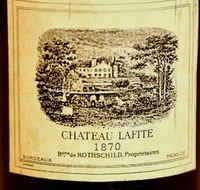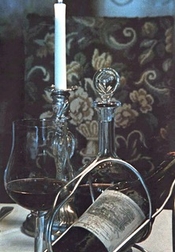-Robert Daley, Esquire Magazine, November 1966
All of us have long histories of wine tasting and enjoyment. I have been privileged to have sampled more than my share of great wines. Some, however, make an indelible impression that is a pleasure to recall. Twenty or so years ago, I had the opportunity to partake in a tasting of one of the greatest wines of all time – the 1870 Château Lafite-Rothschild. This wine is a legend. Powerful and backward in its youth, it was barely drinkable until the 1920’s. The 1870 also predates the invasion of phylloxera in the Bordeaux vineyards. The debate still rages whether ungrafted or “pre-phylloxera” vines yield better wines than their grafted cousins. The grapes used in Lafite, and Bordeaux generally, were different prior to phylloxera. Malbec, Petite Verdot, Carmenère were widely used as were a host of minor varieties that are long forgotten today. The post-phylloxera vineyards were planted to varieties that grafted to resistant rootstocks with fewer problems.

My memorable tasting was in perhaps the quintessential city for such an event – San Francisco. This was indeed theatre of the vine. The stage was set for a great wine – a multi-course meal at a highly regarded restaurant. With a dozen wine professionals from the U.S. and the U.K. in attendance, it would be hard to imagine a group with more wine and food knowledge and wine tasting experience gathered anywhere. Not everyone in the group knew in advance of the specific wine list for the evening. They were informed that a ‘70 Lafite was to be opened up, but it was not until the group convened that everyone realized it was an 1870 Lafite, not a 1970. The element of surprise added to the electricity of the event.
When wine lovers approach an experience like this, it is with a high degree of reverence. They scan their memories to recall the other fine old clarets they might have sampled over the aggregate century plus of serious winetasting. What will a 125+ year old claret taste like? What do I expect? What aromas and flavors will unfurl after a century and more entombed in its glass confine?
Thoughts cross the mind as well of all that has come to pass since those grapes were harvested. Who was President in 1870 anyway? Grant? Yes, that’s it – Ulysses S. Grant. It was five years after the end of the Civil War. Think of the events that have transpired in the last 140 years – two world wars, one cold war, the advent of the automobile, the airplane, the flush toilet, the light bulb, the telephone and on and on. So much has changed in the condition of humanity, yet wine remains somehow comfortingly constant.
What about this specific bottle? Had the sunshine of the previous century been preserved in vinous expression, or had the light of these grapes been extinguished decades ago? That mystery would not be solved until the cork was drawn. The evening began with requisite splendor — the 1870 on display in the decanting cradle while the Champagne was poured and the first three courses were enjoyed with sumptuous, if more modern, wines.

The color was a pale, very mature tawny. The bouquet was truly extraordinary. Surrounding the strikingly vibrant core of cherry fruit was a panoply of woodsy, cedary, floral and spice scents. It was an enchanting perfume that filled the room. Everyone fell silent imprinting the aroma into their memory. Comments were murmured as everyone sniffed, swirled, sipped, swallowed, and savored each drop. In the mouth it was silky, elegant, so very smooth; an impressive array of flowers and fruits and spices. It was, however, an ephemeral experience. After around 20 minutes, the aroma and flavor faded away rather quickly. I sat in silence, secretly thanking those that tended the vines through the heat of that summer and nurtured the fermenting juice into an exquisite beverage I could enjoy over a century later. This venerable bottle indeed went out in a blaze of glory.
Tasting a wine of this nature is memorable event for all those present and one worth reporting on. Wine prices now are substantially higher than they were at the time of my 1870 Lafite tasting, making such experiences even more limited. There are still glorious, iconic, and very old wines out there. If you have an opportunity like this, take advantage of it! You’ll be glad you did.
Read more columns at: Wayne Belding
